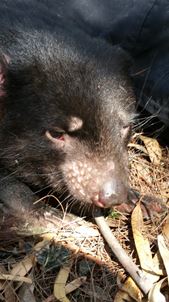
The Tasmanian devil is the world’s largest carnivorous marsupial and is only found in the island state of Tasmania off the southern coast of Australia.
They were named ‘devils’ by the early settlers who thought their loud screeching calls were something out of Dante’s realm.
Devils are about the size of a small dog, are nocturnal and have one of the largest bite-forces in the world. They are carrion scavengers, although they do hunt small prey such as possums, skinks and some birds. Devils traditionally live for 5-6 years in the wild.
An endangered species
Sadly the Tasmanian devil is listed as an endangered species due to a lethal contagious cancer, known as devil facial tumor disease (DFTD).
DFTD is a clonal cell line which is transmitted from devil to devil through biting during feeding or mating. The disease is fatal, as the tumors grow on the face region, devils lose the ability to feed and breathe, finally succumb to the disease.
DFTD has now spread across 80% of Tasmania, causing local population declines as high as 95% in some areas. With the populations now so low – the species is susceptible to all the other threatening processes such as road kill, dog attack, and habitat loss.
Save the Tasmanian devil

There is hope – the Save the Tasmanian Devil Program (STDP) is the official government response to the crisis. STDP is a joint initiative between the Australian federal and Tasmanian governments and the Zoo and Aquarium Association Australasia (ZAA).
In 2006, a captive insurance population was commenced with 40 devils. There are now over 700 devils in disease free sites across Australia including zoos, large fenced enclosures, on an island, and on a fenced peninsula.
One of the important aspects of the insurance population is to ensure that the devils which are released back into the wild are robust and fit, both genetically and physically. This is where our research group comes in.
Working in close collaboration with the STDP and ZAA, our group set out to provide the devil management team with real-time information which informs their decisions and has a direct conservation outcome. Our research covers a variety of topics in fields of genetics, genomics, immunology, and recently, microbiome.
Microbiome research
Microbiome research has been one of the fastest growing areas in life science in recent years. The trillions of microbes that reside in the human body play a vital role in maintaining our health. A disturbed microbiome has been associated with various diseases, such as diabetes, inflammatory bowel disease, rheumatoid arthritis, asthma, some cancers, and even mental disorders.
Understanding the microbiome is also important for conservation – we need to know whether animals that are kept and bred in captivity maintain a microbiome similar to those found in wild animals, or whether captivity alters the microbiome, and potentially the health status of captive individuals.
In the case of the Tasmanian devil, our study showed that the gut, skin, pouch, and oral microbiome of devils in captivity significantly differed from that of wild devils.

This finding did not come as a surprise. Although zoo animals are provided with food and environmental enrichment that imitate their natural diet and habitat, the artificial settings in captivity often can still cause behavioral or physiological changes in animals.
A number of factors, including nutrition, medical treatment, stress, environmental and social conditions, could have contributed to the change in devils’ microbiome in captivity.
We observed certain signs in the microbiome of captive devils that we should be cautious about. For example, compared to wild devils, some zoo devils had considerably lower bacterial diversity in their gut flora – a possible consequence of this could be obesity.
Indeed, we observed that female devils in captivity can weigh up to 10kg, whereas in the wild they are usually less than 9kg. Obesity can be a problem in captive animals as it can lead to reduced success rate of captive breeding.
So how do we manage this?
Another important finding from our study was that devils kept in free-range enclosure were relatively less different from wild devils than those in zoos under more intense management and human disturbance. This tells us that large fenced enclosures are a more preferable option to minimize changes to microbiome in devils.
Our findings highlighted the importance of monitoring and managing the microbiome of captive animals, not only for the Tasmanian devil, but also for the many other endangered species, bred for release to the wild globally. Health and fitness is not only maintained by the external factors that we can see but also by the complex microbial community that lives within.

Our work would not have been possible without the ongoing support of the Save the Tasmanian Devil Program, Zoo and Aquarium Association Australasia, all the ZAA member zoos who hold devils, and the Australian Research Council.
Yuanyuan Cheng, Carolyn Hogg & Kathy Belov
Carolyn Hogg is Research Manager of the Australasian Wildlife Genomics Group in the Faculty of Veterinary Science at the University of Sydney and population advisor for the Save the Tasmanian Devil Program Insurance Metapopulation.
Kathy Belov is Professor of Comparative Genomics in the Faculty of Veterinary Science and Pro-Vice Chancellor (Global Engagement) at the University of Sydney.
Latest posts by Yuanyuan Cheng, Carolyn Hogg & Kathy Belov (see all)
- Saving the Tasmanian devil with microbiome research - 8th April 2016
Comments